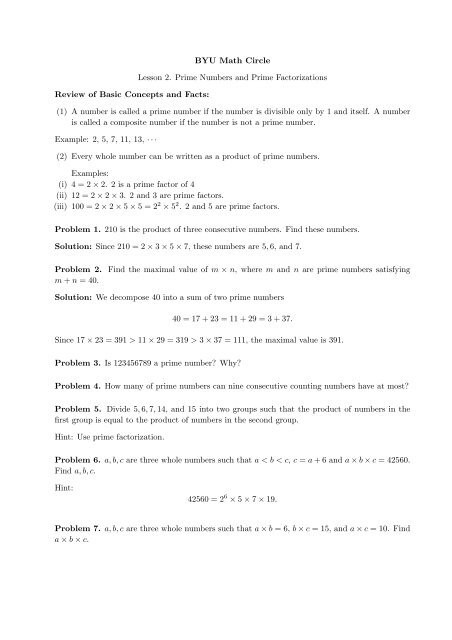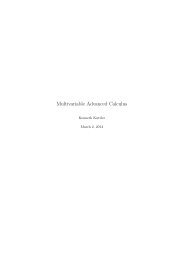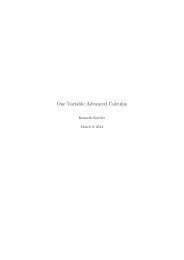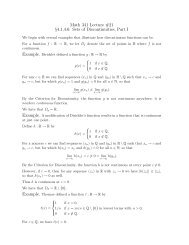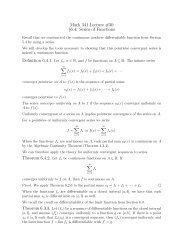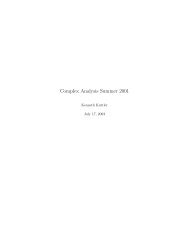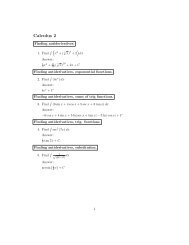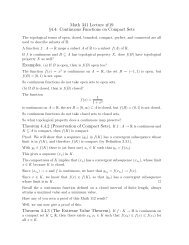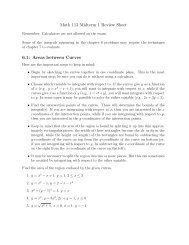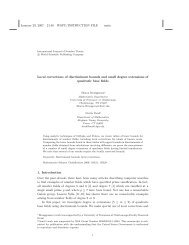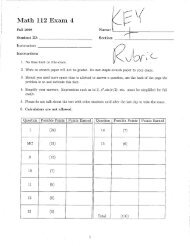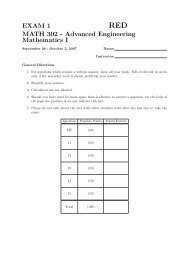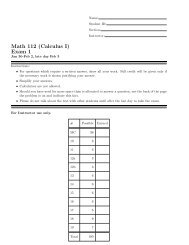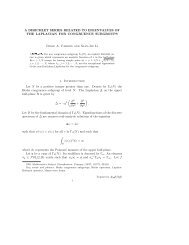BYU Math Circle Lesson 2. Prime Numbers and Prime ...
BYU Math Circle Lesson 2. Prime Numbers and Prime ...
BYU Math Circle Lesson 2. Prime Numbers and Prime ...
- No tags were found...
You also want an ePaper? Increase the reach of your titles
YUMPU automatically turns print PDFs into web optimized ePapers that Google loves.
Review of Basic Concepts <strong>and</strong> Facts:<strong>BYU</strong> <strong>Math</strong> <strong>Circle</strong><strong>Lesson</strong> <strong>2.</strong> <strong>Prime</strong> <strong>Numbers</strong> <strong>and</strong> <strong>Prime</strong> Factorizations(1) A number is called a prime number if the number is divisible only by 1 <strong>and</strong> itself. A numberis called a composite number if the number is not a prime number.Example: 2, 5, 7, 11, 13, · · ·(2) Every whole number can be written as a product of prime numbers.Examples:(i) 4 = 2 × <strong>2.</strong> 2 is a prime factor of 4(ii) 12 = 2 × 2 × 3. 2 <strong>and</strong> 3 are prime factors.(iii) 100 = 2 × 2 × 5 × 5 = 2 2 × 5 2 . 2 <strong>and</strong> 5 are prime factors.Problem 1. 210 is the product of three consecutive numbers. Find these numbers.Solution: Since 210 = 2 × 3 × 5 × 7, these numbers are 5, 6, <strong>and</strong> 7.Problem <strong>2.</strong> Find the maximal value of m × n, where m <strong>and</strong> n are prime numbers satisfyingm + n = 40.Solution: We decompose 40 into a sum of two prime numbers40 = 17 + 23 = 11 + 29 = 3 + 37.Since 17 × 23 = 391 > 11 × 29 = 319 > 3 × 37 = 111, the maximal value is 391.Problem 3. Is 123456789 a prime number? Why?Problem 4. How many of prime numbers can nine consecutive counting numbers have at most?Problem 5. Divide 5, 6, 7, 14, <strong>and</strong> 15 into two groups such that the product of numbers in thefirst group is equal to the product of numbers in the second group.Hint: Use prime factorization.Problem 6. a, b, c are three whole numbers such that a < b < c, c = a + 6 <strong>and</strong> a × b × c = 42560.Find a, b, c.Hint:42560 = 2 6 × 5 × 7 × 19.Problem 7. a, b, c are three whole numbers such that a × b = 6, b × c = 15, <strong>and</strong> a × c = 10. Finda × b × c.
Square Number, or Complete Square:Example: 4 = 2 × 2 = 2 2 , 9 = 3 2 , 16 = 4 2 , 25 = 5 2 , · · ·, n 2 .Problem 8. Find the smallest counting number a such that a × 1080 is a square number.Solution: Note that a prime factor of a square number must appear even times.Since a × 1080 = a × 2 3 × 3 3 × 5, the smallest a = 2 × 3 × 5.Problem 9. How many factors does 360 have?Hint: 360 = 2 3 × 3 2 × 5.Problem 10. How may factors does 240 have?<strong>BYU</strong> <strong>Math</strong> <strong>Circle</strong>Homework (<strong>Lesson</strong> 2)(1) Find all possible pairs of whole numbers a <strong>and</strong> b such that a × b = 105.(2) Find a whole number a such that a × (a + 1) = 1111222<strong>2.</strong>(3) Find five consecutive whole numbers such that their product is 55440.(4) Find the smallest counting number a such that a × 338 is a square number.(5) How many factors does 10500 have?(6) There is a 3-foot tall rectangular container with a base measuring 2 feet by 3 feet. Thecontainer is filled with water 9 inches high. When I place a 1-foot cube on the bottom of thetank, the water rises. How high does the water rise? How high does the water rise when Iplace a second cube on the bottom?A Challenge ProblemYou are given a triangle with two vertices at (1,2) <strong>and</strong> (4,4). The third vertex is located onthe x-axis. Where should the third vertex be located so the area of the triangle is 5 square units?Secondly...if you graph the area of the triangle as a function of the x-coordinate of the thirdvertex, what kind of graph is it? quadratic? cubic? linear?


